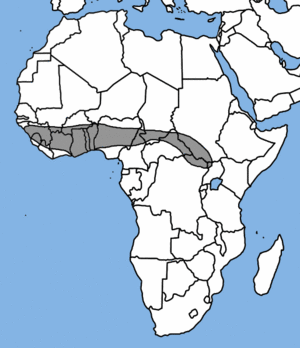Aba roundleaf bat facts for kids
Quick facts for kids Aba roundleaf bat |
|
|---|---|
| Conservation status | |
| Scientific classification | |
| Genus: |
Hipposideros
|
| Species: |
abae
|
 |
|
| Geographic range of the Aba roundleaf bat | |
The Aba roundleaf bat (Hipposideros abae) is a type of bat that belongs to the family Hipposideridae. It's also called the Aba leaf-nosed bat because of its unique nose shape. You can find this bat in West Africa, especially along the southern coast from Nigeria all the way to Senegal. Some groups of these bats have also been seen in Sudan and Uganda.
These bats like to live in warm, wet lowland forests. They also make their homes in dry and moist savannas, and sometimes even in caves.
Contents
What is the Aba Roundleaf Bat?
How the Aba Bat Got Its Name
The Aba roundleaf bat was first described by an American zoologist named Joel Asaph Allen in 1917. He gave it the scientific name abae.
This name comes from the city of Aba, Democratic Republic of the Congo. This is where the first bat of this species was found and studied. It was collected in December 1911.
Two explorers, Herbert Lang and James Chapin, found the bat. They were on an expedition through what was then called the Belgian Congo.
A Bat Family: The Hipposideros Group
The Hipposideros group of bats has many different species. To help organize them, scientists divide them into smaller, related groups.
The Aba roundleaf bat is part of the speoris species group. In this group, it only has one close relative. That relative is the Schneider's leaf-nosed bat, also known as H. speoris.
What Does the Aba Roundleaf Bat Look Like?
Colors and Features of the Aba Bat
The fur on the back of the Aba roundleaf bat is a brownish color. This color goes from its shoulders down to the rest of its body.
Its head, neck, and shoulders are usually a bit lighter than its back. Each hair on its back has two colors. The bottom part of the hair is lighter than the tip.
The fur on its belly is a grayish-yellow color. Its throat is much lighter than the rest of its underside.
The bat's ears and feet are light brown. Its wing membranes, which are the skin that forms its wings, are dark brown.
Size of the Aba Roundleaf Bat
This bat is about 104 mm (4.1 in) long from head to tail. Its tail itself is about 38 mm (1.5 in) long.
Its foot measures about 12 mm (0.47 in). Its ears are about 20 mm (0.79 in) tall. The forearm, which is a key measurement for bats, is about 58.5 mm (2.30 in) long.
Different Color Phases
Aba roundleaf bats can have different fur colors. Scientists have described three main "color phases" for them.
These phases are: a dark phase, a red phase, and an intermediate phase. This means you might see bats of this species with slightly different shades of fur.
Where Does the Aba Roundleaf Bat Live?
Countries Where the Aba Bat is Found
The Aba roundleaf bat has been seen in many countries. These include Guinea-Bissau, Guinea, Sierra Leone, and Liberia.
It also lives in Côte d'Ivoire, Burkina Faso, Ghana, and Togo. You can find it in Nigeria, Cameroon, and the Central African Republic. It has also been recorded in Sudan, the Democratic Republic of Congo, and Uganda.
Even though there are no official records from Mali, Benin, or Chad, scientists believe it probably lives there too. This is because these areas are between places where the bat is known to live.
Preferred Homes of the Aba Bat
This bat likes to live in a mix of forest and savanna areas. It can also be found in rainforests that have been changed by humans.
The Aba roundleaf bat has not been found in places higher than 1,000 m (3,300 ft) above sea level. This means they prefer lower elevations.
Is the Aba Roundleaf Bat Endangered?
Conservation Status of the Aba Bat
The IUCN currently lists the Aba roundleaf bat as "least concern". This is good news for the species.
This means that the bat is not in immediate danger of disappearing. It has a wide area where it lives, which helps its population.
The bat can also handle some changes to its habitat. Its population is not thought to be decreasing quickly.
In fact, this bat can even benefit from deforestation. When forests are cleared, the bat can use the new open land as a place to live.


